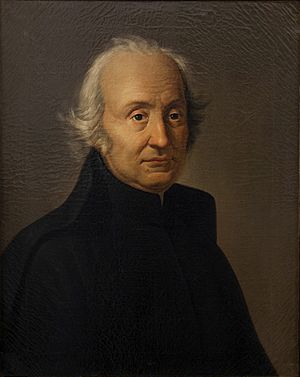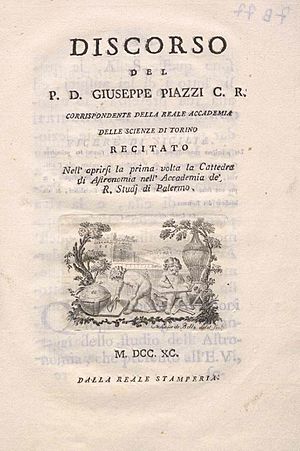Giuseppe Piazzi facts for kids
Quick facts for kids
Giuseppe Piazzi
|
|
|---|---|
 |
|
| Born | 16 July 1746 Ponte in Valtellina
|
| Died | 22 July 1826 (aged 80) Naples, Kingdom of Naples
|
| Nationality | Italian |
| Awards | Lalande Prize (1803) |
| Scientific career | |
| Fields | Astronomy |
Giuseppe Piazzi (born July 16, 1746 – died July 22, 1826) was an Italian priest, mathematician, and astronomer. He is famous for discovering Ceres, which was the first dwarf planet ever found. Piazzi also started an important observatory in Palermo, Italy. Today, it's called the Osservatorio Astronomico di Palermo – Giuseppe S. Vaiana.
Contents
Giuseppe Piazzi's Early Life
Not much is known about Giuseppe Piazzi's early science education. He likely studied in Turin, Italy. He probably attended lessons by Giovanni Battista Beccaria, a famous scientist. From 1768 to 1770, Piazzi lived in Rome. There, he studied mathematics with François Jacquier.
In July 1770, he became a professor of Mathematics at the University of Malta. Later, in December 1773, he moved to Ravenna. He taught Philosophy and Mathematics at the Collegio dei Nobili until 1779.
Becoming an Astronomy Professor
After short stays in Cremona and Rome, Piazzi moved to Palermo in March 1781. He became a lecturer in Mathematics at the University of Palermo. He held this job until January 19, 1787. Then, he became a Professor of Astronomy.
Around the same time, he got permission to travel. He spent two years in Paris and London. His goal was to get practical training in astronomy. He also wanted to order special instruments for the new Palermo Observatory. He was in charge of setting up this observatory.
Building the Palermo Observatory
While abroad, from 1787 to 1789, Piazzi met many famous astronomers. He also had a special instrument built. This was the altazimuthal circle, made by Jesse Ramsden. Ramsden was a very skilled instrument-maker.
This circle became the most important tool at the Palermo Observatory. The observatory officially opened on July 1, 1790. In 1817, King Ferdinand asked Piazzi to finish the Capodimonte (Naples) Observatory. Piazzi became the General Director of both the Naples and Sicily Observatories.
Piazzi's Astronomy Career
Giuseppe Piazzi made important contributions to astronomy. He created a detailed star catalog. He also discovered the first dwarf planet.
Creating Star Catalogs
Piazzi oversaw the creation of the Palermo Catalogue of stars. This catalog listed 7,646 stars. It was very precise for its time. It included stars like the "Garnet Star" and the original Rotanev and Sualocin. The first edition of this catalog was finished in 1803. A second edition came out in 1814.
After discovering Ceres (see below), Piazzi continued his work. He studied how stars move across the sky. He looked for stars that could help measure parallax. Parallax is how astronomers figure out how far away stars are.
One star, 61 Cygni, was a great candidate. Later, Friedrich Wilhelm Bessel successfully measured its parallax. Because of Piazzi's work, 61 Cygni is sometimes called Piazzi's Flying Star. It is also known as Bessel's Star.
Discovering the Dwarf Planet Ceres
Giuseppe Piazzi discovered Ceres. On January 1, 1801, Piazzi saw a "stellar object." It seemed to move against the background of fixed stars. At first, he thought it was just another star. But when he saw it move, he realized it was something new. He thought it might be a planet. He called it "a new star."
Even though he suspected it was a planet, he announced it as a comet. He could not observe it for very long. It soon disappeared behind the bright glare of the Sun. Piazzi could not figure out its orbit using the methods available then.
How Ceres Was Found Again
A mathematician named Carl Friedrich Gauss developed a new way to calculate orbits. This new method helped astronomers find Ceres again. Once its orbit was better understood, it was clear. Piazzi was right; it was not a comet. It was more like a small planet.
Interestingly, it was found almost exactly where the Titius-Bode law predicted a planet would be. Piazzi named it "Ceres Ferdinandea." He named it after Ceres, the Roman and Sicilian goddess of grain. He also honored King Ferdinand IV of Naples and Sicily. The "Ferdinandea" part was later removed for political reasons.
Ceres turned out to be the first and largest of the asteroids. These asteroids are found in the asteroid belt. Today, Ceres is known as a dwarf planet.
Posthumous Honours for Piazzi
Giuseppe Piazzi received many honors after his death. The astronomer Charles Piazzi Smyth was named after him. Charles was the son of astronomer William Henry Smyth.
In 1871, a statue of Piazzi was put up in his hometown, Ponte. The sculptor was Costantino Corti. In 1923, the 1000th asteroid to be officially named was called 1000 Piazzia. The lunar crater Piazzi on the Moon was named after him in 1935. More recently, a large feature on Ceres was seen by the Hubble Space Telescope. It is probably a crater and has been informally named Piazzi.
Works
- (in it) Discorso recitato nell'aprirsi la prima volta la Cattedra di astronomia nell'Accademia de' r. Studj di Palermo. Palermo: Stamperia reale. 1790. https://gutenberg.beic.it/webclient/DeliveryManager?pid=4642534.
See also
 In Spanish: Giuseppe Piazzi para niños
In Spanish: Giuseppe Piazzi para niños
- Niccolò Cacciatore, his assistant and successor in the post as director
- List of Roman Catholic scientist-clerics



